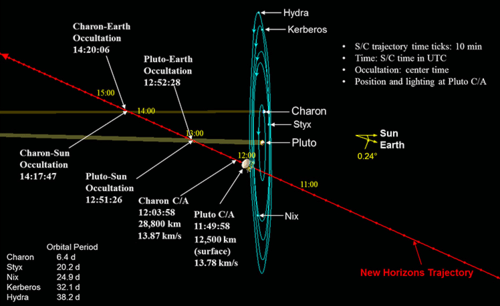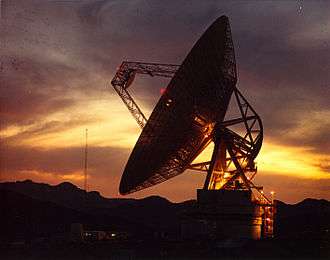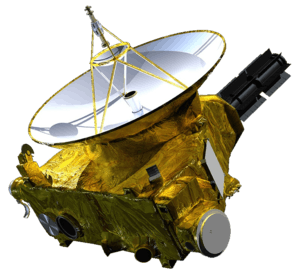REX (New Horizons)
REX or Radio Science Experiment is an experiment on the New Horizons space probe to determine various aspects of the atmosphere of Pluto during the 2015 flyby.[1] It is an experiment designed with several goals including to determine the pressure and temperature of Plutonian atmosphere, to measurements of a possible ionosphere of Pluto and/or Charon, to record thermal emission temperatures, and to take more accurate chord lengths of Charon and Pluto.[2]


To accomplish the objectives, as the spacecraft passes by Pluto, it is targeted on a path that takes it behind the dwarf planet in relation to where Earth is, and at that time radio signals from the flyby spacecraft pass through atmosphere of body, and from this various aspects can be determined.[3] REX also is designed to take measurements of the atmospheric conditions at Pluto's moon Charon as part of the mission.[4] REX utilizes an ultrastable oscillator, various electronics, and radio hardware aboard the New Horizons spacecraft.[5] REX utilizes the X-band radio uplink on the spacecraft.[6]
REX hardware weights 160 g (0.16 kg) and consumes 1.6 watts of spacecraft electrical power.[7] It also makes use of other NH hardware, overall key hardware components for REX include:[6]
- high-gain antenna
- low-noise X-band receiver
- ultrastable oscillator
To take the measurements, REX communicates with the Deep Space Network back on Earth.[8] REX can also directly measure the thermal radiation of Pluto at 4.2 cm wavelength.[9]
Observation goals:[10]
- temperature profiles of Pluto's atmosphere
- pressure profiles of Pluto's atmosphere
- radiometric temperature
- gravitational moments
- ionosphere structure
Extended mission
REX is also planned for use in the New Horizon's post Pluto extended mission, including the 486958 Arrokoth flyby.[11] REX will be used to take thermal measurements of the Kuiper belt body during the planned flyby.[12] REX is also used to study the amount of electrons in outer space in the Kuiper belt region.[13] The Kuiper belt is a ring of orbiting bodies between approximately 30 to 55 AU (Earth-Sun distances), home to Pluto and short-period comets it is estimated to consist of hundreds of thousand if not millions of small icy objects.[14] The belt was discovered starting in 1992, and can be studied more closely by the New Horizons mission which is passing through it starting in the late 2010s.[15]
During the post Pluto cruise, REX is usually turned on monthly to measure the electron density of the solar wind between Earth and the spacecraft.[16] When New Horizons flew by Pluto in 2015, it was at about 32.9 AU from the Sun, and about 43.6 AU for the New Year's Day 2019 flyby of Arrokoth.[17][18]
The timing of the Arrokoth flyby was adjusted in part to aid the use of the REX experiment, in particular time it so more radar dishes on Earth could be used for this experiment.[19]
Data from REX
Using REX radio occultation data the diameter of Pluto was found to be 2376.6±3.2 km in a 2017 paper.[20]
See also
- Gravity science (Juno) (Experiment aboard Juno Jupiter orbiter that uses radio and time)
- Mariner 4 (radio experiment helped determine more accurate atmospheric conditions about Mars in the 1960s)
References
- Tyler, G. L.; Linscott, I. R.; Bird, M. K.; Hinson, D. P.; Strobel, D. F.; Pätzold, M.; Summers, M. E.; Sivaramakrishnan, K. (2008-02-21). "The New Horizons Radio Science Experiment (REX)". Space Science Reviews. 140 (1–4): 217–259. Bibcode:2008SSRv..140..217T. doi:10.1007/s11214-007-9302-3. ISSN 0038-6308.
- Tyler, G. L.; Linscott, I. R.; Bird, M. K.; Hinson, D. P.; Strobel, D. F.; Pätzold, M.; Summers, M. E.; Sivaramakrishnan, K. (2008-02-21). "The New Horizons Radio Science Experiment (REX)". Space Science Reviews. 140 (1–4): 217–259. Bibcode:2008SSRv..140..217T. doi:10.1007/s11214-007-9302-3. ISSN 0038-6308.
- Linscott, I.; Hinson, D. P.; Bird, M. K.; Stern, A.; Weaver, H. A.; Olkin, C.; Young, L. A.; Ennico Smith, K. (2015). "The New Horizons Radio Science Experiment: Performance and Measurements of Pluto's Atmospheric Structure, Surface Pressure, and Surface Temperature". AGU Fall Meeting Abstracts. 2015: P54A–05. Bibcode:2015AGUFM.P54A..05L.
- "The Radioscience Experiment on New Horizons - IEEE Conference Publication". doi:10.1109/URSIGASS.2011.6051216. Cite journal requires
|journal=(help) - Tyler, G. L.; Linscott, I. R.; Bird, M. K.; Hinson, D. P.; Strobel, D. F.; Pätzold, M.; Summers, M. E.; Sivaramakrishnan, K. (2008-02-21). "The New Horizons Radio Science Experiment (REX)". Space Science Reviews. 140 (1–4): 217–259. Bibcode:2008SSRv..140..217T. doi:10.1007/s11214-007-9302-3. ISSN 0038-6308.
- I., Linscott; P., Hinson, D.; K., Bird, M.; A., Stern; Jr., Weaver, H. A.; C., Olkin; A., Young, L.; K., Ennico Smith (December 2015). "The New Horizons Radio Science Experiment: Performance and Measurements of Pluto's Atmospheric Structure, Surface Pressure, and Surface Temperature". AGU Fall Meeting Abstracts. 2015: P54A–05. Bibcode:2015AGUFM.P54A..05L.
- Cedric, Leyrat; Alice, Le Gall; Ralph, Lorenz; Shadi, Boomi (October 2017). "Predicted Antenna Temperatures Measured by REX/New Horizons During The Pluto's FlybyProbing the sub-surface in Microwave". Aas/Division for Planetary Sciences Meeting Abstracts #49. 49: 215.03. Bibcode:2017DPS....4921503L.
- "The Radioscience Experiment on New Horizons - IEEE Conference Publication". doi:10.1109/URSIGASS.2011.6051216. Cite journal requires
|journal=(help) - Stern, S. A.; Weaver, H. A.; Spencer, J. R.; Elliott, H. A.; the New Horizons Team (2018). "The New Horizons Kuiper Belt Extended Mission". Space Science Reviews. 214 (4): 77. arXiv:1806.08393. Bibcode:2018SSRv..214...77S. doi:10.1007/s11214-018-0507-4.
- Stern, S. A.; Weaver, H. A.; Spencer, J. R.; Elliott, H. A.; the New Horizons Team (2018). "The New Horizons Kuiper Belt Extended Mission". Space Science Reviews. 214 (4): 77. arXiv:1806.08393. Bibcode:2018SSRv..214...77S. doi:10.1007/s11214-018-0507-4.
- Stern, S. A.; Weaver, H. A.; Spencer, J. R.; Elliott, H. A.; the New Horizons Team (2018). "The New Horizons Kuiper Belt Extended Mission". Space Science Reviews. 214 (4): 77. arXiv:1806.08393. Bibcode:2018SSRv..214...77S. doi:10.1007/s11214-018-0507-4.
- "Kuiper Belt". Solar System Exploration: NASA Science. Retrieved 2018-10-26.
- "The PI's Perspective: Why Didn't Voyager Explore the Kuiper Belt? – Pluto New Horizons". blogs.nasa.gov. Retrieved 2018-10-26.
- Bagenal, F.; Delamere, P. A.; Elliott, H. A.; Hill, M. E.; Lisse, C. M.; McComas, D. J.; McNutt Jr, R. L.; Richardson, J. D.; Smith, C. W.; Strobel, D. F. (2015). "Solar wind at 33 AU: Setting bounds on the Pluto interaction for New Horizons". Journal of Geophysical Research: Planets. 120 (9): 1497–1511. arXiv:1509.04660. Bibcode:2015JGRE..120.1497B. doi:10.1002/2015JE004880.
- "New Horizons". pluto.jhuapl.edu. Retrieved 2018-10-26.
- "New Horizons prepares for encounter with 2014 MU69". www.planetary.org. Retrieved 2018-11-07.
- Nimmo, Francis; et al. (2017). "Mean radius and shape of Pluto and Charon from New Horizons images". Icarus. 287: 12–29. arXiv:1603.00821. Bibcode:2017Icar..287...12N. doi:10.1016/j.icarus.2016.06.027.
